Dr. Utr. Iur.
Frank
Van den Broeke
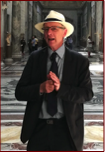
To book an authorised guided tour with me: .... Click here
Wine & Dine: ... Click here
Where to buy your tickets ... ? Click here
In the following words Giorgio Vasari describes the scene, in his Lives of Artists : “The story of Ahasuerus, reclining in his bed and causing the Chronicles to be read, has equal merit. The figures are very fine, and among them are three men, seated at a table eating, who represent the deliberation of those who sought to free the Jewish people and to compass the death of Haman. The figure of the latter is likewise seen foreshortened in a very extraordinary manner, the stake which supports his person and the arm which he stretches before him appearing not to be painted but really round and in relief, as does also the leg, which he projects outward, and the portions of the body which are bent inward. This is indeed a figure which, among all beautiful and difficult ones, is certainly the most beautiful and most difficult.”
In the Book of Esther is said that Haman was hanged on the gallows which he had been erected for Mordocai. Michelangelo, instead, is hanging Haman on the cross. In the Vulgate (Esther 5: 14) there is a single phrase where the word “crux” is used to describe the form of the scaffold - which, everywhere else in the narrative, is unambiguously described as the gallows (1).”responderuntque ei Zares uxor eius et ceteri amici iube parari excelsam trabem habentem altitudinem quinquaginta cubitos et dic mane regi ut adpendatur super eam Mardocheus et sic ibis cum rege laetus ad convivium placuit ei consilium et iussit excelsam parari crucem” (in translation: 'Have a fifty-cubit gallows run up,' said Zeresh his wife and all his friends, 'and in the morning ask the king to have Mordecai hanged on it. Then you can go with the king to the banquet, without a care in the world!' Delighted with this advice, Haman had the cross erected.)
Dante used certainly the Vulgate as source for his epic work, and even is the “cross” only appearing once in the Book of Esther instead of the “gallows”, It was sufficient for Dante to use the image of the cross as a prefiguration of Jesus on the cross. And we know that Michelangelo was inspired by Dante’s Divine Comedy. And more, he put Haman in a position that is similar to the Laocoon, a statue that was recently discovered in the golden house of Nero. When it was found back, Michelangelo added the missing hands, not like a greek sculptor would do by keeping the hands within the triangle that starts from the head. No, he gives it a christian twist: a man dies with his sons and seeks salvation. If you are putting the drawings that Michelangelo made of Haman, it shows a lot of similarities with the Laocoon, who also wanted to change the history. If the people of Troy would have believed him, Troy wouldn’t have been destroyed and put to flames. And Aneas would never had escaped the fire with his father and son, and they would never have arrived in Italy. The vestal virgin Rea Sylvia, a descendent of Aeneas would never had become the mother of Romulus and Remus .... and Rome wouldn’t have existed.
In a similar way, the humility and courage of Esther exposes to the King that Haman wants to destroy them. Just like Laocoon, who wanted to change the history, Haman wanted to do so by whipping out the Jewish race. The prophecies of the arrival of the Messiah in the old testament would never been fulfilled and the evil would have annihilated the Jewish people and mankind would never have been saved by Jesus’ sacrifice on the cross. Haman died on the cross, so that the Jewish people could live. The wickedness of Haman is judged, and punished. Hamans death saved the Jewish people from genocide. But also Hamans hands seems to be groping for something beyond his grasp. The gesture is that of one reaching out, in vain, towards the helping hand of another(note 1), just like the Laocoon.
The book of Esther is celebrated in the Hebrew liturgy on the feast of Purim, after a period of fastening. The origins of the feast (sometimes with orgies) are commemorated in the book of Esther. Similar as the feast of the Passover, were Moses crossed the red sea and relieved the people from it’s enemies. (note 3)
So the dead of the wicked Haman will save the Jewish people from the genocide organized by Haman. The Jews celebrated the death of Haman on the second day Passover, which also happened to be the day of Christ’s cruxifixion.
Until 408, with the Theodosian codex, an ancient Jewish tradition celebrated the death of Haman and the delivery of Israel by staging a mock-crucifixion. The Theodosian Codex forbid this because Jesus died on the cross during the feast of Passover. (1)
The words of the Theodosian Codex are very clear: VIII, 18. The governors of the provinces shall prohibit the Jews, in a certain ceremony of their festival Haman in commemoration of some former punishment, from setting fire to and burning a simulated appearance of the holy cross, in contempt of the Christian faith and with sacrilegious mind, lest they associate the sign of Our faith with their places. They shall maintain their own rites without contempt of the Christian law, and they shall unquestionably lose all privileges that have been permitted them heretofore unless they refrain from unlawful acts (29 May 408).
Further evidence exists of Christian belief in Jewish celebration of Haman’s crucifixion. Thus a later Byzantine Christian baptismal formula for Jewish converts imprecates those who nail Haman to wood in the shape of the cross, burning him in effigy and thus exposing Christian to maledictions. The formula reads: “I next curse those who keep the festival of the so-called Mordecai on the first Sabbath of the Christian fasts (=Lent), nailing Haman to wood and then mixing with him the emblem of a cross and burning them together, subjecting Christians to all kinds of imprecations and a curse.” (note 2)

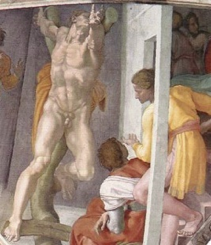
One of the most powerful lunettes of the Vault of the Sistine Chapel is the “Death of Haman”, a story as described in the book of Esther, 3.
Let’s start with an extract of the Book of Esther .... and then see what Michelangelo made of it.
(by reading the blue characters you have the plot)
2,21 At this time Mordecai was attached to the Chancellery and two malcontents, Bigthan and Teresh, officers in the king's service as Guards of the Threshold, plotted to assassinate King Ahasuerus. 2,22 Mordecai came to hear of this and informed Queen Esther, who in turn, on Mordecai's authority, told the king. 2,23 The matter was investigated and proved to be true. The two conspirators were sent to the gallows, and the incident was recorded in the Annals, in the royal presence.
3,1 Shortly afterwards, King Ahasuerus singled out Haman son of Hammedatha, a native of Agag, for promotion. He raised him in rank, granting him precedence over all his colleagues, the other officers-of-state, 3,2 and all the royal officials employed at the Chancellery used to bow low and prostrate themselves whenever Haman appeared -- such was the king's command. Mordecai refused either to bow or to prostrate himself. 3,3 “Why do you flout the royal command?' the officials of the Chancellery asked Mordecai. 3,4 Day after day they asked him this, but he took no notice of them. In the end they reported the matter to Haman, to see whether Mordecai would persist in his attitude, since he had told them that he was a Jew. 3,5 Haman could see for himself that Mordecai did not bow or prostrate himself in his presence; he became furiously angry. 3,6 and, on being told what race Mordecai belonged to, he thought it beneath him merely to get rid of Mordecai, but made up his mind to wipe out all the members of Mordecai's race, the Jews, living in Ahasuerus' entire empire.
6,1 That night the king could not sleep; he called for the Record Book, or Annals, to be brought and read to him. 6,2 They contained an account of how Mordecai had denounced Bigthan and Teresh, two of the king's eunuchs serving as Guards of the Threshold, who had plotted to assassinate King Ahasuerus. 6,3 'And what honor and dignity', the king asked, 'was conferred on Mordecai for this?' 'Nothing has been done for him,' the gentlemen-in-waiting replied. 6,4 The king then said, 'Who is outside in the antechamber?' Haman had, that very moment, entered the outer antechamber of the private apartments, to ask the king to have Mordecai hanged on the gallows which he had just put up for the purpose.
7,1 The king and Haman went to Queen Esther's banquet, 7,2 and this second day, during the banquet, the king again said to Esther, 'Tell me your request, Queen Esther. I grant it to you. Whatever you want; even if it is half my kingdom, it is yours for the asking.' 7,3 'If I have found favor in your eyes, O king,' Queen Esther replied, 'and if it please your majesty, grant me my life -- that is my request; and the lives of my people -- that is what I want. 7,4 For we have been handed over, my people and I, to destruction, slaughter and annihilation; had we merely been sold as slaves and servant-girls, I should not have said anything; but in the present case, it will be beyond the persecutor's means to make good the loss that the king is about to sustain.' 7,5 King Ahasuerus interrupted Queen Esther, 'Who is this man?' he exclaimed. 'Where is the man who has thought of doing such a thing?' 7,6 Esther replied, 'The persecutor, the enemy? Why, this wretch Haman!' Haman quaked with terror in the presence of the king and queen. 7,7 In a rage the king got up from the banquet and went into the palace garden; while Haman, realizing that the king was determined on his ruin, stayed behind to beg Queen Esther for his life. 7,8 When the king came back from the palace garden into the banqueting hall, he found Haman sprawled across the couch where Esther was reclining. 'What!' the king exclaimed. 'Is he going to rape the queen in my own palace?' The words were scarcely out of his mouth than a veil was thrown over Haman's face.
7,9 In the royal presence, Harbona, one of the officers, said, 'There is that fifty-cubit gallows, too, which Haman ran up for Mordecai, who spoke up to the king's great advantage. It is all ready at his house.' 'Hang him on it,' said the king. 7,10 So Haman was hanged on the gallows which he had erected for Mordecai, and the king's wrath subsided.
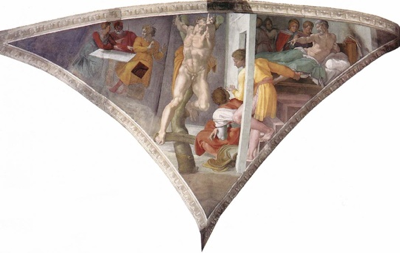
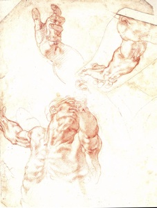
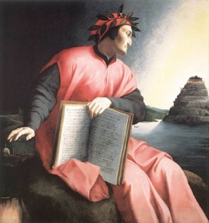
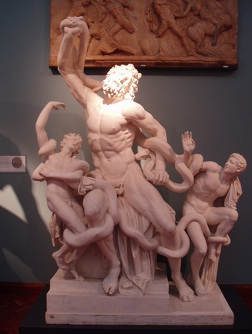
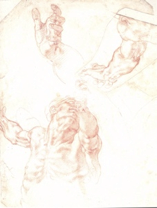
“Then reigned within my lofty fantasy
One crucified, disdainful and ferocious
In countenance, and even thus was dying.
Around him were the great Ahasuerus
Esther his wife, and the just Mordecai,
Who was in word and action so entire.
And even as this image burst asunder
Of its own self, in fashion of a bubble
In which the water it was made of fails,
There rose up in my vision a young maiden
Bitterly weeping, and she said: “O queen,
Why hast thou wished in anger to be naught?”
(Dante Alighieri, Divine Comedy, Pulgatorio, XVII, 9-12)
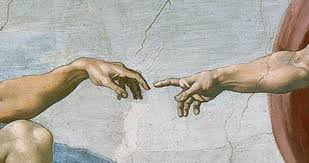
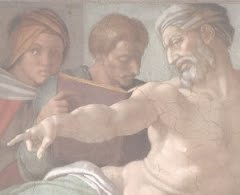
I created a few layers of where Michelangelo might have token his inspiration: The Laocoon and The Creator (the legs on left are a flipped version of the drawing in the British Museum
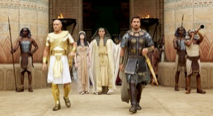
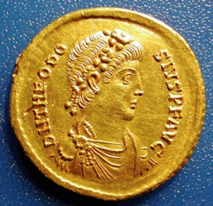

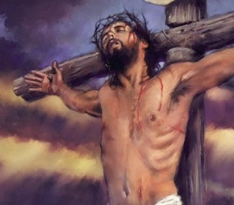
And Michelangelo took exactly the cross. Why? Maybe, through His dead, He made that we should live. It is the folly of the cross as described in the first letter of St. Paul to the Corinthians. 1 Cor 1, 18-31.
“The message of the cross is folly for those who are on the way to ruin, but for those of us who are on the road to salvation it is the power of God. As scripture says: I am going to destroy the wisdom of the wise and bring to nothing the understanding of any who understand. Where are the philosophers? Where are the experts? And where are the debaters of this age? Do you not see how God has shown up human wisdom as folly? Since in the wisdom of God the world was unable to recognize God through wisdom, it was God's own pleasure to save believers through the folly of the gospel. While the Jews demand miracles and the Greeks look for wisdom, we are preaching a crucified Christ: to the Jews an obstacle they cannot get over, to the gentiles foolishness, but to those who have been called, whether they are Jews or Greeks, a Christ who is both the power of God and the wisdom of God. God's folly is wiser than human wisdom, and God's weakness is stronger than human strength. Consider, brothers, how you were called; not many of you are wise by human standards, not many influential, not many from noble families. No, God chose those who by human standards are fools to shame the wise; he chose those who by human standards are weak to shame the strong, those who by human standards are common and contemptible -- indeed those who count for nothing -- to reduce to nothing all those that do count for something, so that no human being might feel boastful before God. It is by him that you exist in Christ Jesus, who for us was made wisdom from God, and saving justice and holiness and redemption. As scripture says: If anyone wants to boast, let him boast of the Lord.”
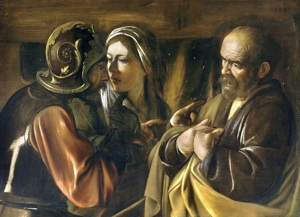
G.K. Chesterton makes this following statementt:
“When Christ at a symbolic moment was establishing His great society. He chose for its corner-stone neither the brilliant Paul nor the mystic John, but a shuffler, a snob, a coward- in a word, a man. And upon this rock He has built his Church, and the gates of Hell have not prevailed against it. All the empires and the kingdoms have failed, because of this inherent and continual weakness, that they were founded by strong men and upon strong men. But this one thing, the historic Christian Church, was founded on a weak man, and for that reason it is indestructible. For no chain is stronger than its weakest link.”
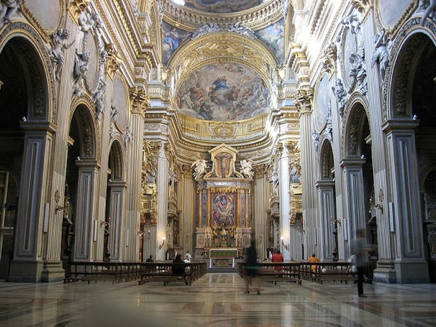
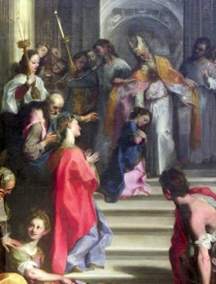
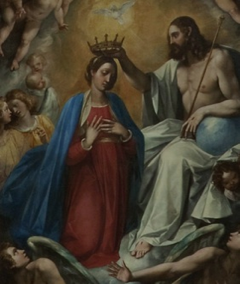
Probably the most iconic church in the world dedicated to Mary is the one built by saint Philip Neri in 1575 after the council of Trent, the Chiesa Nuova or Santa Maria in Vallicella. For those who love Mary, its the best church in his kind in the world. (click for having a virtual tour). Totally dedicated to Mary. It’s Her life from alfa to omega. It starts with the painting of Federico Barocci, “The presentation of Mary in the temple” (1602). Mary is kneeled in front of the Cohen, the High-priest for receiving his blessing. Look close at Her position, a young girl, presented by her mother Anna (unusual presented as a young mother in red). Mary kneels, without headscarf -innocent- and with her hands folded on her brest, humble requesting the blessing.
And look now at the painting on the other side in the same church: the end of the cycles about Mary, omega. Mary is crowned in heaven. Look again the hands and the head ! You can see that - for such a famous painter as Cavaliere d’Arpino- the hands of Mary here are not his most successful. And if you look close, it’s seems that around her head there was a headscarf!!
When the work was delivered, the fathers of the Oratory of saint Philip Neri were theological not pleased with it. Mary’s hands were folded as in prayer and she had a headscarf. Cavaliere d’Arpino was forced to alter the painting by giving it a more correct theological version of the action. Scarf was removed and hands were laid in the same position as in the Presentation of Federico Baroccio on the other side. (note 4)
Indeed, once you are in heaven, there is no adoration with folded hands like in a prayer to God anymore, you are becoming one with Him. But now, Mary stands in the humble position of her immaculate and innocent youth. A women who question herself Why she deserved the crown ? What for special she had done that no other mother would have done? She was giving birth to a child, tried to protect is by escaping to Egypt, raised it, accepted his destiny, still believing in her Son, even when the people called him crazy, still believed Him when others condemned Him. She stayed on His side until His dead on the cross and kept His memory alive until the Holy Spirit came down, even when all the others (Peter ....) had left him. Which mother wouldn’t do thàt for her son ??? No, Mary was sure that she didn’t deserve it to become the queen of Heaven.
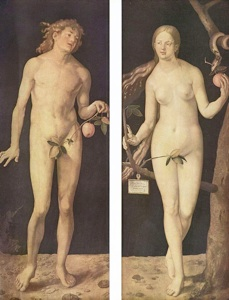
The old Testament has a tradition of covering as a symbol of the knowledge of good and evil, and that people sinned in the eyes of God. It started with Adam and Eve as here in the work of Albrecht Dürer, but also King David. Only the innocent can face the Lord uncovered. And is Mary not the Immaculate, the one conceived without original sin? If the prophet Isaiah was allowed to get uncovered, how much more Mary.
Haman covered his head, because he new that his thoughts were sinful.
'Hurry,' the king said to Haman, 'take the robes and the horse, and do everything you have just said to Mordecai the Jew, who works at the Chancellery. On no account leave out anything that you have mentioned.' So taking the robes and the horse, Haman arrayed Mordecai and led him on horseback through the city square, proclaiming before him: 'This is the way a man shall be treated whom the king wishes to honour.' After this Mordecai returned to the Chancellery, while Haman went hurrying home in dejection and covering his face.
The king (David) covered his face and cried aloud, "O my son Absalom! O Absalom, my son, my son!"
at that time the LORD spoke through Isaiah son of Amoz. He said to him, "Take off the sackcloth from your body and the sandals from your feet." And he did so, going around stripped and barefoot.
The nobles send their servants for water; they go to the cisterns but find no water. They return with their jars unfilled; dismayed and despairing, they cover their heads.
You will keep your turbans on your heads and your sandals on your feet. You will not mourn or weep but will waste away because of your sins and groan among yourselves.
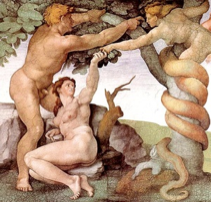
Note (1) GRAHAM-DIXON, Andrew, Michelangelo and the Sistine Chapel, Weidenfield & Nicolson, London, 2008, 126-127
Note (2) The translation is from Thornton (“Haman”, 24), The original text appears in the appendix to the Clementine Recognitions in PG 1, 1457C.
Note (3) (On December 5th 2014, Sir Ridley Scott will release a new epic movie about the Exodus.)
Note (4) Archivio della Congregazione dell’Oratorio (ACO), C.I.6, p.16: July 9, 1615 and July 12, 1615.
In March 1617 the painting is still not ready for being exposed in the church and there is asked for
retouchings. (ACO, C.I.6, p.29)
This second “pentimento” is visible in particular light conditions and became evident in a photo made during it’s last restoration. (Soprintendenza per I Beni Artistici e Storici di Roma, neg. nn. 127276 and 127292); look also at: Santa Maria in Vallicella, BARBIERI, BARCHIESI, FERRARA, Fratelli Palombi Editori, Roma, 1995, 84 ss. and note 399.

Similar arms, only one different finger, why ?
The Death of Haman, book of Esther
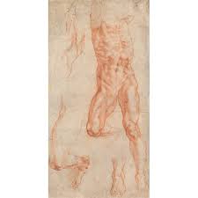
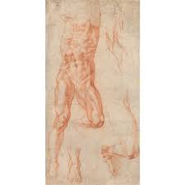
Sistine Chapel
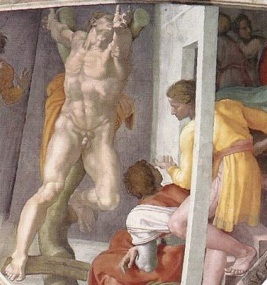
Maybe is here one of the best arguments against the niqab and the burka in the world. Even Michelangelo in the sistine chapel affirms that not Eve is the only one who is guilty of the original sin(the knowledge of good and evil.) . Also Adam is! An he depicted the sinfall in such a way that Adam takes the apple by himself. We are all guilty of the original sin. And for taken that away, the Lord sent his only Son who asked: “Who is without sin takes the first stone .... and one after the other left.”
Esther is therefore also the prefiguration of Mary; in the Bible Esther is praised for her humility, her fasting and her praying for finding courage. The Roman Catholic church is reading the book of Esther on the first Thursday of Lent - a time of fastening. And the face of Ester is inspired by Michelangelo’s own Pietà in the St. Peter’s Basilica, made only a few years earlier. The humble Mary accepted the divine conception of her son, and accepted the divine counsel of the Angel. In a similar way Esther in prayer and fasting accepted the counseling of her father Mordocai. Esther, the queen, intercedes by the King for saving her people, just like Mary, the queen in heaven, intercedes in her intercessory power with the King of Heaven. The Lord listens always to a contrived and humble hearth.
if you want to leave a commentary, please feel free to do so:
And indeed, the Church isn’t build on the clergy -and when most of them are good, some of them are weak and gave scandal-, but the Catholic Church is build on it’s saints and those who are willing to pick up their cross. Just like Caravaggio paint the conversion of saint Paul. When he falls of the horse, he spreads his hands in the position of the cross, just like saint Peter on the opposite painting when he get crucified. He got blind, but received the grace of the inner light that made him ready to pick up his cross.
In a similar way Christ used the weapon of his enemies, the cross. By killing Christ on the cross, they hoped to kill Jesus and his message. But the cross became a symbol of victory ! In Collosians, 2,14-15 we read: He has wiped out the record of our debt to the Law, which stood against us; he has destroyed it by nailing it to the cross; and he has stripped the sovereignties and the ruling forces, and paraded them in public, behind him in his triumphal procession.
If Jesus didn’t die on the cross, He would never have freed mankind from evil. Maybe Haman is rather the evil murderer on the cross besides Jesus, who didn’t accept grace, but only looked at his own pride and career. Haman becomes the anti-type of Christ. And those who are picking up the cross will have the power of the Jews and the wisdom of the Greek: The power of loving and the wisdom to share it.
Esther .... Mary? Let’s go to Santa Maria in Vallicella in Rome
The denial of Peter by Carvaggio
